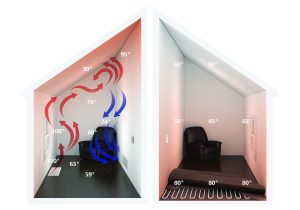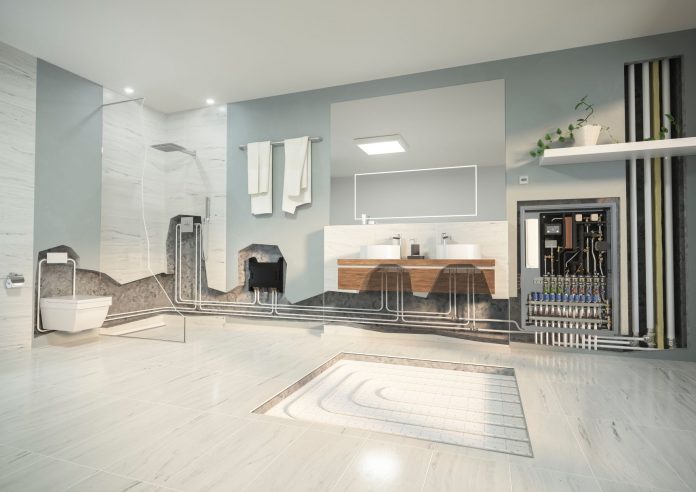Mark Dowdeswell, senior category manager at Uponor, discusses the new standards and how installing low-temperature, energy-efficient systems, such as underfloor heating, can help housebuilders and developers to meet these new requirements for low-carbon heating
The long-anticipated update to Part L of the Building Regulations which was introduced on 15th June 2022 is viewed by many as the most far-reaching changes to housing standards for decades.
Why have the Building Regulations been changed?
It is estimated that around 20% of carbon emissions come from new homes. With this in mind, the goal of the updated regulations is to make homes zero-ready so that we can achieve net zero by 2050. No home will ever be net zero, but the idea is that the carbon emissions produced by our homes can be offset by the amount removed. For a home to be zero-ready, it should be built so that it does not require any major retrofitting or intervention to make it zero carbon in the future.
The revisions to Part L were introduced alongside changes to Part F and the introduction of Part O (ventilation) by The Department for Levelling Up, Housing and Communities (DLUHC) in response to the public consultation on the Future Buildings Standard. These interim uplifts are seen as a stepping stone to ensuring that all new homes built from 2025 are net zero-ready and will produce 75% fewer carbon emissions than those built under the 2013 regulations.
What are the main changes to the Building Regulations?
The regulations came into effect on 15th June, but there is a grace period until 15 June 2023 for buildings that are currently in the planning process. Any projects with planning permission under the old regulations must start work by the 15th June 2023, otherwise, the new regulations will apply.
Key points to the Part L uplift include:
- All new homes must produce 31% less co2 emissions compared to the 2013 standards.
- New heating systems must be designed with a maximum flow temperature of 55°C
- Zones within a home will need to have self-regulating control devices for heating systems
- An onsite audit will be required on new builds to confirm that they have been constructed in line with the (Building Regulations England Part L) BREL report`
Anyone responsible for the building work, including the agent, designer, builder or installer, must ensure that work carried out complies with the requirements of Part L. The changes also affect anyone undertaking their own extension, renovation or self-build project.
These changes are a shake-up on the previous Building Regulations and are designed to improve the efficiency performance of new homes and drive towards the 2025 carbon ready and the Future Homes Standard, and then the final 2050 zero-carbon target.
In addition, by introducing the requirement for on-site audits and evidential photographs, there is now a greater focus on quality assurance, transparency and accountability.
What are the options for the decarbonisation of buildings?
These changes, together with the decarbonisation of the energy grid to move away from our reliance on gas, are all part of the push to encourage housebuilders, developers and homeowners to look at alternative technologies to achieve low-temperature heating.
Changing heat distribution systems across the UK will be a challenge. Research published by the BEIS in March 20211 found that up to 90% of all heating systems may need to be upgraded to be able to provide sufficient thermal output to heat a home when operating at a lower temperature on a peak winter’s day.
This could mean installing low-temperature radiators that include expensive fan technology to achieve adequate heat output when running at the lower temperature of 55°.
Otherwise, traditional radiator sizes would need to increase significantly, which is something many homeowners would not want, particularly when space is limited or aesthetics are a concern.
Low carbon hydrogen has long been touted as the answer to replacing fossil fuels and in August 2021 the Government launched the UK’s first-ever hydrogen strategy to help drive forward the Prime Minister’s ambitious Ten Point Plan for a Green Industrial Revolution. However, while this could well be an option for the future, the technology is not quite there yet. In fact, the Government stated in its Heating and Building Strategy in October 20212 that it has delayed deciding how to integrate hydrogen heating into homes until 2026.
While there are already several renewable energy heat sources available such as waste water heat recovery (WWHR) units and solar PV panels, heat pumps are expected to become the primary heating technology for new homes, particularly as the Government has set a target to install 600,000 heat pumps per year by 2028.
What are the benefits of underfloor heating?
Radiant heating distribution systems designed to operate at low flow temperatures are a key enabler of low-carbon heat which makes underfloor heating the ideal solution for meeting the new regulation. In fact, both Part L and the Future Homes Standard feature low-temperature heating as the future for heat emitters. This is backed up further by the UK Energy-related Products Policy (ErP) Study3 which indicated that there could be considerable savings from moving to low-temperature emitters.
Traditional convectional radiators often have one or two square metres of heat-emitting surfaces in a room and distribute heat upwards through a smaller heat-emitting area, which can lead to temperature differentiation (hot and cold spots) within a space, or room. Meanwhile, underfloor heating systems have a very large heat transfer surface which provides an even spread of radiant heat across the entire space.
A further benefit of underfloor heating is that it is already designed for zonal control so that each area can be controlled individually from a central thermostat, smartphone or even voice control systems such as Alexa. Being able to control individual zones or rooms provides a better thermal environment as people tend to prefer a different temperature at varying times in a bedroom to a living room or bathroom.
UFH systems are also able to run at a lower temperature due to their larger surface area which means that they are ideally suited to work effectively alongside both air source heat pumps (ASHP) and ground source heat pumps (GSHP). The overall efficiency of a heat pump is determined by the temperature output from the heat source – the lower the supply temperature, the higher the pump’s performance factor. So, with underfloor heating systems running at between 35°C-55°C, as opposed to a traditional boiler running at around 70°C, UFH enables heat pumps to work at their most efficient capacity, particularly when the heat pump is connected with pre-insulated pipe systems which ensure minimal heat loss.
Meeting current and future requirements
We already have the solutions for low-temperature heating in place to meet the uplift in Part L and help us to achieve our 2025 zero-ready and 2050 net zero targets. Underfloor heating systems combined with heat pumps not only comply easily with the new regulations and upcoming requirements but can also future-proof the home.
As climate change continues and the number of hot days increases each year, the demand for cooling in our buildings is likely to increase. In addition to providing radiant heating via warm water, UFH systems can also provide radiant cooing during the warmer winter months.
So while standards and legislation focus on new builds, it’s important to remember that these properties will not always be ‘new builds,’ they will become homes for future generations so will need to be able to meet the demands of the future occupants.
Energy efficiency is becoming an increasingly important factor for people when buying a home and is now part of their purchasing list. So, designing energy-efficient, low-temperature heating and cooling into a building from the start is important if housebuilders and developers want to lower carbon emissions and provide a cost-effective and comfortable home for the future.
References
- BEIS: Domestic heat Distribution Systems: Gathering Evidence
- Heating and Buildings Strategy October 2021
- UK Energy-related Products Policy Study














